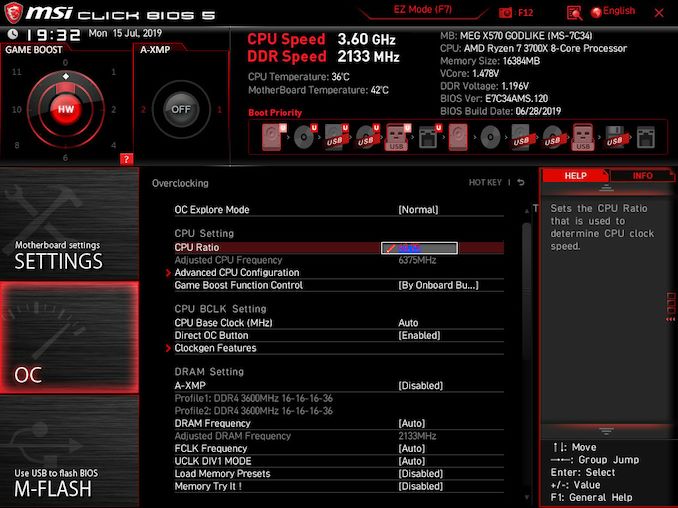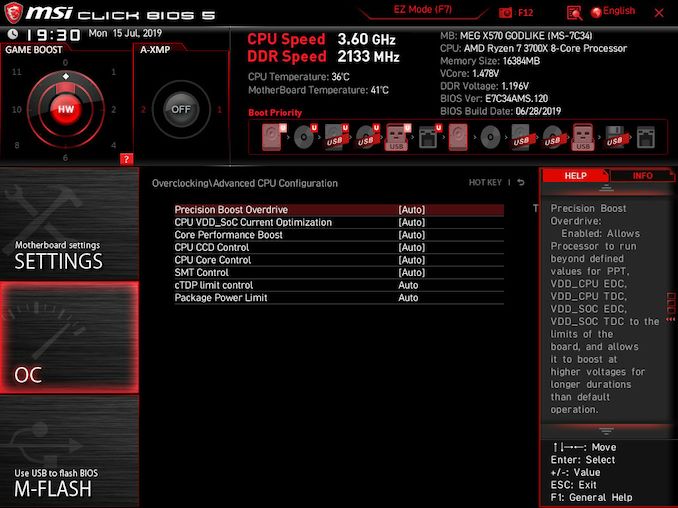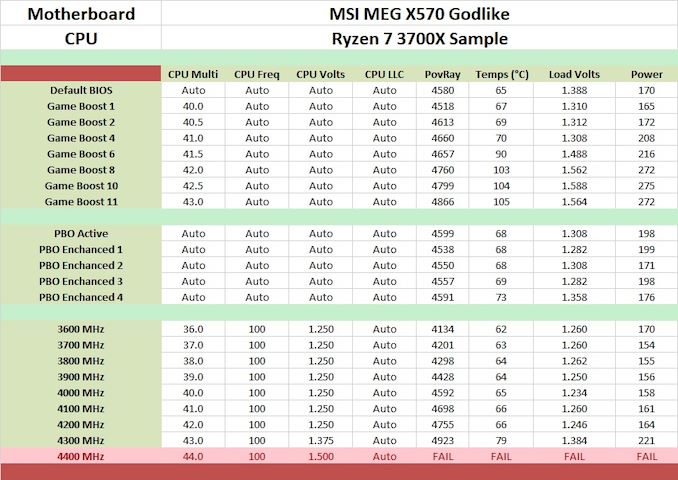The MSI MEG X570 Godlike Motherboard Review: Thor's Flagship
by Gavin Bonshor on August 28, 2019 12:00 PM EST- Posted in
- Motherboards
- AMD
- MSI
- 10G Ethernet
- Ryzen
- PCIe 4.0
- Ryzen 3000
- X570
- X570 Godlike
- MEG
Overclocking Ryzen 3000
Experience with the MSI MEG X570 Godlike
Overclocking with the Ryzen 3000 series hasn't exactly titillated users since its launch with there not being much headroom available. The biggest issue with this boils down to all-core overclocks being limited by the worst core of the chip. and the new 7 nm processors running quite warm. To get the best experience and results with the Ryzen 3000, users with good quality AIOs and custom water cooling yields the best outcome, and even with voltages of 1.375 V, these chips can run a little too warm for comfort.
The MSI Click BIOS 5 firmware is familiar to us and throughout the different chipsets including X399, X470, and Z390, the MSI MEG X570 Godlike uses the same design layout and setup. Within the OC section of the firmware, users can alter important settings such as the CPU ratio which can be changed in steps of 0.25 MHz, with relevant settings including CPU VCore, CPU Base Clock, and even FCLK frequency. Deeper into the firmware is settings to set the load line calibration (LLC) to a more aggressive or liberal profile, as well as all the Precision Boost Overdrive (PBO) settings.
The three main settings that PBO works from include package power tracking (PPT), thermal design current (TDC), and the electrical design current (EDC). All three of these can be set within the firmware under the advanced section of the Precision Boost Overdrive menu, although MSI has included four different PBO profiles for users to select from. The higher the setting, the higher the thermal and power draw will be, and it may not necessarily matter if a sub-par cooler is installed; it's noted that Ryzen 3000 processors work better when they are cooler.
There are seven different MSI Game Boost profiles to select from and users can access them via the dial at the bottom of the board, or through the firmware itself. The Game Boost profiles within the firmware can be accessed through the dial in the top left-hand corner. These profiles range from 4.0 GHz through to 4.3 GHz, and we've tested each of them below.
Overclocking Methodology
Our standard overclocking methodology is as follows. We select the automatic overclock options and test for stability with POV-Ray and OCCT to simulate high-end workloads. These stability tests aim to catch any immediate causes for memory or CPU errors.
For manual overclocks, based on the information gathered from the previous testing, starts off at a nominal voltage and CPU multiplier, and the multiplier is increased until the stability tests are failed. The CPU voltage is increased gradually until the stability tests are passed, and the process repeated until the motherboard reduces the multiplier automatically (due to safety protocol) or the CPU temperature reaches a stupidly high level (105ºC+). Our testbed is not in a case, which should push overclocks higher with fresher (cooler) air.
Overclocking Results
As it currently stands, MSI's Game Boost overclocking profiles need quite a bit of refinement, something they have informed us that these will be rectified with a new firmware revision; we will test this when we receive the board back from MSI. The issue with these is CPU VCore, or in a nutshell, too much of it which cross the board into the unsafe territory of the Ryzen 3000 processors safety limits; both in CPU VCore and in temperature. When we activated PBO and MSI's preset profiles for this, it didn't make much of an impact over the stock settings, which seems to be a reoccurring issue so far across the range of models we have tested so far.
Manually overclocking the MSI MEG X570 Godlike proved very fruitful and we managed to hit what seems to be the limits of our Ryzen 7 3700X testbed CPU with an overclock of 4.3 GHz all-cores with a CPU VCore of 1.35 V, which seems to be the brick wall for our processor. Even with a CPU VCore of 1.50 V, we couldn't get 4.4 GHz to remain stable when any kind of semi-intensive load was placed on the processor, although we did manage to boot into Windows 10 without fanfare with these settings. The performance wasn't throttled in POV-Ray throughout each of the frequencies tested and once the temperature limit of 110ºC is exceeded, the system will safely shut down. From 3.6 to 4.2 GHz, we managed to do this with a set CPU VCore of 1.250 V which did fluctuate slightly under load under the auto LLC setting. It is safe to say that the MSI MEG X570 Godlike doesn't have a VDroop issue and even at 4.3 GHz, a set CPU VCore of 1.375 resulted in a maximum load voltage of 1.384 V which isn't too far off the mark.













116 Comments
View All Comments
StrangerGuy - Friday, August 30, 2019 - link
Totally agreed, especially in this age where Youtubers have pushed the hardware e-peen waving and elitism all the way up to the high heavens.I'm using a 8700K. but I happily game on a Ryzen 1600 that's $80 used from Aliexpress with a new $65 B450 mobo if I had to; it's bizarre to see people buying into the overpriced marketing kool-aid while simultaneously whining about how expensive the hobby is.
RamarC - Thursday, August 29, 2019 - link
all i can say is "JeeBuz!"WaltC - Thursday, August 29, 2019 - link
I wanted to add my experience with my last MSI mboard that used the ALC1220 & the Nahimic 3.x software--when I got into this x570 Aorus Master and cranked up the ALC1220 & the ESS Sabre DAC, with headphone amp, all hardware, I couldn't believe how much the sound quality improved! Gawd, it was like night and day--same headphones! It was difficult to believe that @ $700 MSI went with the exact same sound hardware and software processing they put in their $190 Ryzen1 mboards--like the Gaming Pro Carbon! Remarkable! So glad I went with Aorus this time. This x570 Master is a keeper. Believe me--I have nothing against MSI--and if the Master was a poor board I'd say so....! No problem. Right now it is shaping up to be one of the best boards I've ever owned--if not the best. And for $700 I could buy two of them. Remarkable.Techie2 - Thursday, August 29, 2019 - link
What a stupid name for a mobo and an absurd price tag. Only a fool would buy this mobo.twtech - Thursday, August 29, 2019 - link
This one is definitely representative of the "Walmart kid's toy for 7-year-olds" styling that seems to have taken over the motherboard market in recent years.Not only does it have lots of non-functional, flimsy-looking plastic, it even has a cheap mirror on it - why?
PeachNCream - Friday, August 30, 2019 - link
The gaming set consists largely of tweens and man children so dinky plastic covers and a vanity mirror would very much appeal to those juvenile-minded sorts. Alternatively, MSI might be trolling them by giving them a mirror in which to look with shame upon themselves as they use a $700 motherboard to play video games from their parents' house as opposed to getting a job as something other than a part time Uber driver so they can live on their own.Korguz - Friday, August 30, 2019 - link
too bad it isnt a mirror.. but an lcd screen of sorts ?PeachNCream - Saturday, August 31, 2019 - link
You're not really into that whole reading the article thing are you?Oxford Guy - Thursday, August 29, 2019 - link
A god-like 40mm fan!PeachNCream - Friday, August 30, 2019 - link
Maybe if MSI covered the chipset in something other than stupid, angular, RGB-festooned plastic like maybe a decent sized heat sink, there would be no need for a half shrouded, dead-in-11-months little fan. But if they did that, where would they plaster the cartoon dragon?